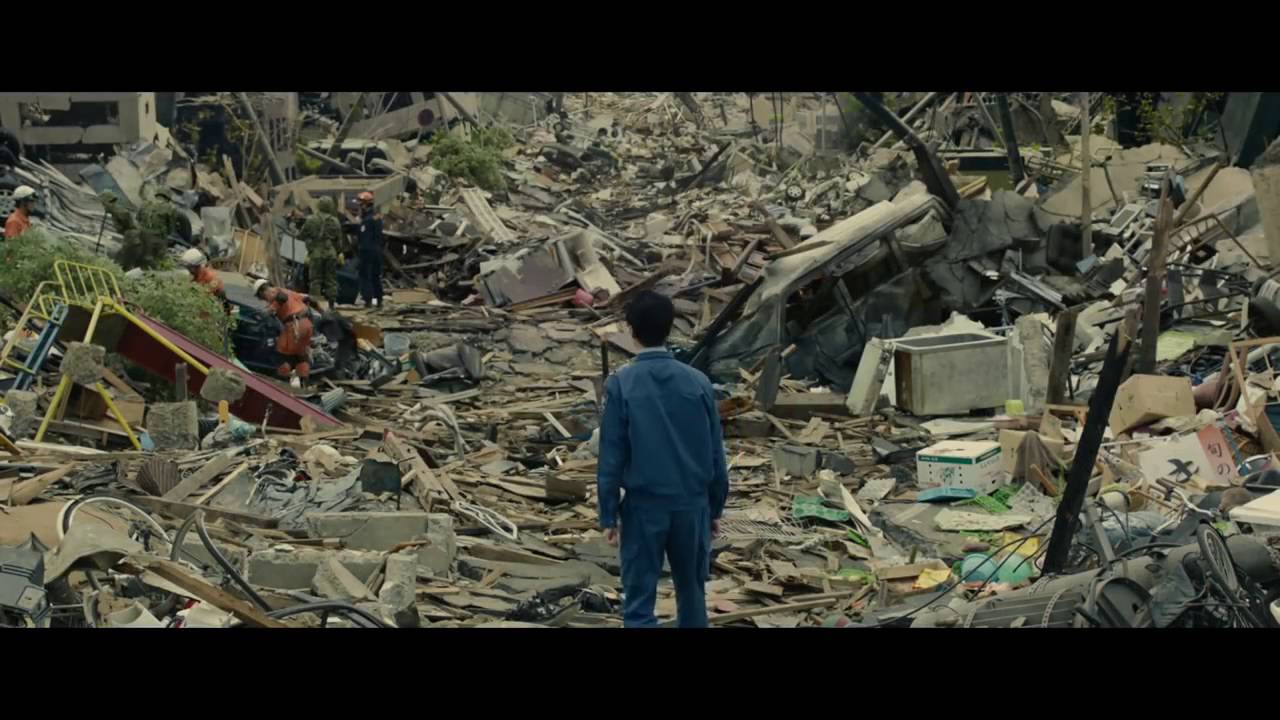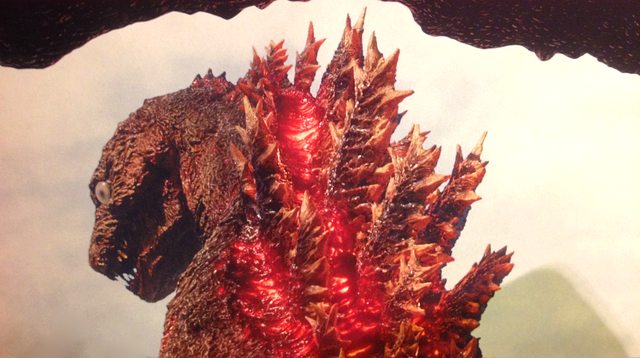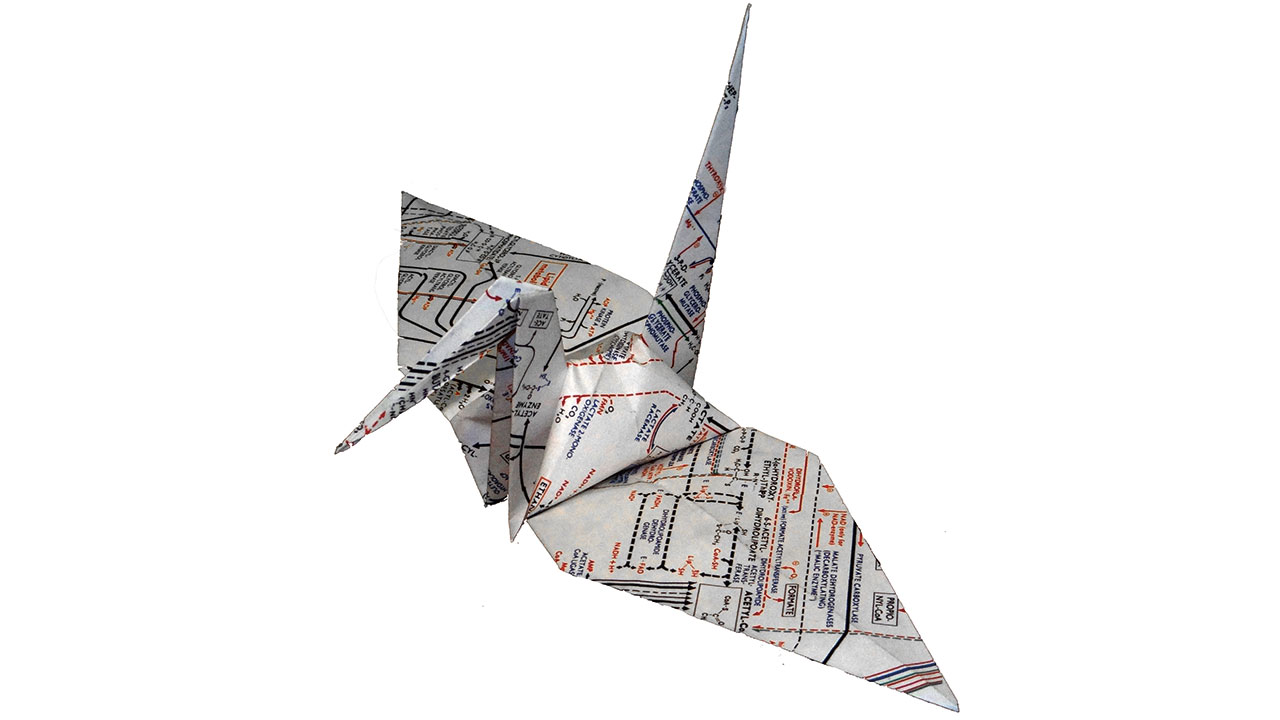by Brian Hioe
語言:
English
Photo Credit: Shin Godzilla
HIDEAKI ANNO’S Shin Godzilla would be an unusual movie, much of the film playing out sometimes much more like a documentary about government bureaucrats rather than like a Godzilla film. That the film has been commercially successful in Japan would be a testament to how the film strikes at something at the core of post-Fukushima Japan. Likewise, the film is strongly reflective of the present moment of uncertainty with constitutional reinterpretation of Article 9 of the Japanese constitution on the table.
Anno would seem the like perfect choice to direct a Godzilla film. After all, the director, famous for anime series as the legendary postmodern giant robot series Neon Genesis Evangelion, got his start in tokusatsu films. At 23, Anno and friends would direct a surprisingly professional fanmade version of Ultraman entitled Ultraman Returns, Anno himself starring as Ultraman. Some thirty years after playing a tokusatsu hero who fought off kaiju in a student production, it would be that Anno has come full circle to become director of a film featuring Japanese kaiju icon Godzilla.
 Rando Yaguchi. Photo credit: Shin Godzilla
Rando Yaguchi. Photo credit: Shin Godzilla
But Shin Godzilla would be a highly unconventional film in its focus, honing in on idealistic, early middle aged Deputy Chief Cabinet Secretary Rando Yaguchi, and the team of Japanese government officials he assembles to deal with threat of Godzilla. Obviously, the choice of generally colorless government bureaucrats as protagonists of a monster film is an odd one. When the monster strikes Tokyo, Yaguchi is the first to realize that the Japanese government is dealing with a biological organism and that the circumstances require urgent and immediate action. Half-hearted attempts by government officials to avoid public blowback lead to disastrous evacuation efforts and Godzilla leveling Tokyo, before eventually Yaguchi and company are able to come up with a plan to deal with the monster.
Godzilla’s scenes of destruction as he rampages through Tokyo and the scenes of government-led evacuation deliberately recall scenes of evacuation after 2011 Fukushima nuclear disaster. The conceptual leap from the nuclear-powered monster Godzilla to the 2011 Fukushima nuclear disaster is an easy one to make, Godzilla having originated in post-war Japanese film as an embodiment of Japan’s grappling with the legacy of World War II and the use of the atomic bomb against Japan during World War II. But scenes of mass panic during evacuation and of government bureaucrats holding press conference after press conference with new excuses after mishandled situations are also clearly meant to evoke the poor government response to the Fukushima disaster. Attempts to evade responsibility and pass the buck are the actions of Japanese bureaucrats who are not necessarily flatly characterized villains, but lack the idealism that Yaguchi and his team retain, these individuals having long since given into cynicism.
In particular, reflective of Japan’s incipient constitutional crisis, the film spotlights attempts to root through Japanese laws to find a legal justification for the use of military, and long scenes of reluctance to use military force by the Japanese Prime Minister. The present reinterpretation of Article 9 by Shinzo Abe and the political forces behind him is an act which threatens to powerfully transform post-war Japanese identity as founded around a notion of pacifism and never taking actions as waging the Second World War again. So, if the initial reluctance of government officials to use military force against Godzilla probably will be lost on western audiences, this is why this is such a pressing matter in the film.
 Film still. Photo credit: Shin Godzilla
Film still. Photo credit: Shin Godzilla
And, in this sense, Shin Godzilla is very clearly attempting an allegory for current Japanese society. This is echoed in scenes depicting what realistic reactions of the Japanese public to an impending Godzilla attack would be and attempts to spotlight the everyday of Japanese life, perhaps seen most strikingly after the first aborted military confrontation with Godzilla suddenly cuts to a montage set to jazz music of Tokyo going about its morning routine as Godzilla’s attack upon the city is imminent—an event which threatens to shatter the everyday of Japanese life altogether. This montage is highly reminiscent of a similar scene in Evangelion 2.0: You Can (Not) Advance and, if the sudden shift to a montage of Japanese everyday life is likely a puzzling one for many audience members of Shin Godzilla who came expecting only a monster movie, this may be the most artistically impressive scene of the movie.
Likewise, with scenes of Japanese Cabinet officials chafing against America’s behavior towards Japan but requiring America’s help to deal with Godzilla and eventual heavy-handed action by America in its efforts to try and kill Godzilla, Anno also makes it quite clear that his view of Japan is that it is a state subordinate to America—a view he probably shares with his mentor Hayao Miyazaki, a former radical leftist during the 1960s with a reputation for distaste for America. The film’s worldview also suggests that America could once again deal violence to Japan if America views it necessary, America being willing to drop nuclear weapons on Japan as part of its efforts to stop Godzilla. Is this also suggestive of current sentiment within Japan, with America seen as willing to sacrifice Japan for its own interests if needed where the Japan-America security alliance is concerned?
This may not play well with an American audience, which is for the most part not aware of Japan’s military subordination to America or of American bases on Japanese soil and probably will find how America is depicted in the film to be cartoonishly sinister. American critics seem to have in particular responded badly to the character of American government agent Kayoko Ann Patterson, a Japanese-American, whom they view as an unsympathetic and stereotyped character. But arguably the character of Kayoko comes out of a longer tradition of initially selfish, but later more sympathetic female characters who are part-Japanese in Anno’s oeuvre, including Asuka Langley Soryu in Evangelion and Jung Freud in Gunbuster.
 Kayoko Ann Paterson. Photo credit: Shin Godzilla
Kayoko Ann Paterson. Photo credit: Shin Godzilla
As with other live-action films by Anno, the documentary impulse of Anno’s filmmaking shines through in both scenes of government crisis response, decision-making, and the eventual actions of the Japanese military. While documentary-style monster films have been aplenty after 2000, the truly unusual focus of Shin Godzilla, then, with would be that the film engages primarily with how the Japanese government and military would realistically respond to a threat as Godzilla—even if the final solution of bringing Godzilla down by freezing him is a science-fiction throwback to older Godzilla films, in which it is a common tactic by the Japanese Self-Defense Force to try to stop Godzilla by freezing him.
Anno’s obsessive, fannish attention to detail is particularly evident in which captions are used indicate different government bureaus or military divisions or technical explanations of military hardware employed in efforts to stop Godzilla. Though some scenes in the film seem to make citations of the work of Mamoru Oshii, much of this is directly drawn from Evangelion. Seeing as film composer Shiro Sagisu was also composer on Evangelion, in a scene of logistical preparation for the final battle with Godzilla highly reminiscent of the iconic battle against the Angel Ramiel in episode 6 of Evangelion, the theme of “Decisive Battle” from Evangelion is played.
But despite this suggestion of realism it would also be that Shin Godzilla in many ways a wishful fantasy. After the poor government handling of the Fukushima disaster, Godzilla can act out the fantasies of an enraged public by serving as a proxy to act out anger towards ineffectual government officials. For example, after finally reaching Tokyo after a long crawl across Japan and leveling the city, Godzilla climactically destroys a government helicopter with the prime minister and other cabinet officials in it with his atomic breath, a scene which stands out for its impressive use of special effects. We can view the film as being a revenge fantasy in many ways. This would be part of what some have termed the film’s “soft nationalism.”
 Film still. Photo credit: Shin Godzilla
Film still. Photo credit: Shin Godzilla
There are in effect four categories of character within the film. First, the cynical, high-ranking, older government bureaucrats who mishandle the situation with Godzilla. Second, the idealistic, younger, and more able government bureaucrats led by Yaguchi. Third, the heroic and anonymous policemen, firefighters, and military staff who are involved in evacuation efforts from the threat of Godzilla or attempts to bring down the monster. And fourth, the nameless crowds who flee in terror from the giant lizard monster and have to be rescued by the policemen, firefighters, and military.
Being a kaiju movie, it would be that the audience is not here for the human characters. In this way, all human characters in the film are for the most part flat characters. As such, there is no real need to develop them as fully realized characters, although Anno does an impressive job making a large number of otherwise anonymous characters have distinguishable character traits. But while, again, even the older government bureaucrats are depicted sympathetically, the film’s “soft nationalism” is very clear in how policemen, firefighters, and military staff are homogeneously depicted as heroic and self-sacrificing. While both the older government bureaucrats and Yaguchi’s team of younger bureaucrats are vested with some interiority—such as in expressions of fear, anger, or self-doubt—this is totally absent from the single-minded policemen, firefighters, and military staff for whom there is not the slightest bit of fear facing down Godzilla. Presumably, this is because of their sense of patriotic duty. There is also the notion that the common masses need to be saved by such noble-minded individuals.
But the film can be more directly nationalist at times as well. In a scene before the final confrontation with Godzilla, Yaguchi declares the JSDF to be the hope of Japan. Is Anno in support of the constitutional reinterpretation of Article 9, in order to allow Japan to stand against the world, then? If so, Anno would be diverging a great deal from the path of his mentor, Hayao Miyazaki, who has expressed strong opposition to Article 9 reinterpretation even if his own work demonstrates some sense of nostalgia for the Japanese military, as evidenced in his final film, The Wind Rises. This would be seem to be a divisive issue in the anime industry, as with Japanese society more generally. For example, the ending of the 2013 Ghost in the Shell Arise, penned by Tow Ubukata, can be interpreted as in support of Article 9 reinterpretation.
 Film still. Photo credit: Shin Godzilla
Film still. Photo credit: Shin Godzilla
Anno would also seem to suggest that the Japanese government needs a generational shift, allowing younger, more idealistic individuals as Yaguchi to take power. Sounding somewhat like a shonen manga protagonist, Yaguchi mentions that his dream is to become prime minister of Japan and enact reform within government several times in the movie. Indeed, though not inherently nationalistic in and of itself, the call for young people to rise up and lead would also be the suggestion in something like Kenji Kamiyama’s 2009 Eden of the East.
The film’s defeat of Godzilla also evokes a form of Japanese cultural nationalism, with the suggestion that it is a combination of Japan’s technological achievements and the Japanese everyday which overwhelms the monster. Godzilla is defeated by freezing the monster through pumping coagulant into Godzilla’s mouth after incapacitating it. This is done through unconventional assaults on the monster, including sending bullet trains packed with explosives crashing into the monster when it crosses train tracks, collapsing office buildings onto the building, and holding it down with construction vehicles. Though somewhat ridiculous as a scene, the use of bullet trains in this climactic assault against Godzilla would use a prominent symbol of Japanese technology in order to finally bring down the monster. In particular, the collapsing of buildings onto Godzilla, which specifically shown to be office buildings with cutaway shots into the buildings’ interior before they are exploded, can be read as collapsing onto the monster a ubiquitous feature of everyday Japanese life—the corporate office of Japanese salarymen. In the end, this is what allows for Godzilla’s defeat—the means by which Japanese science and technological achievement are sufficient to defeat the monster. This more broadly represents how the Japanese everyday is able to triumph over cataclysmic ruptures of the everyday such as that Godzilla represents, as returning to the role of Godzilla as a metaphor for disasters in Japan as the 1945 atomic bombing of Hiroshima or the 2011 Fukushima disaster.
But nationalistic sentiments are not exactly new to Godzilla films. The Heisei era Godzilla’s origin story is that it was alive during World War II as a dinosaur that had survived into the modern era, which defends Japanese imperial soldiers under attack by American soldiers by killing the American soldiers until it is mortally wounded by the American soldiers. After being exposed to nuclear radiation after its death, it is then that this dinosaur becomes Godzilla. So such nationalist sentiments may not necessarily originate from Anno but may have been an element of Godzilla films from the beginning. Ultimately, this returns to the strange way in which Japan comes to reflect on World War II and the atomic bombing of Hiroshima by restaging such disasters in film through inventing a monster that rises from the sea to level Japanese cities in similar manner to World War II, and then this monster in itself becoming iconic of Japan internationally.
Origami prop used in the film. Photo credit: Shin Godzilla
Yet the film ends on an unusually ambiguous note. Again, after Godzilla’s defeat by Yaguchi and his team by freezing the monster, it would be that human ingenuity and science has triumphed over the monster—probably more generally a throwback to the attitudes of faith in science and technology to resolve humanity’s problems that were common in anime from Anno’s youth. A message advocating peace is suggested in some way, because the solution to defeating Godzilla is arrived at by epiphany from a member of Yaguchi’s team staring at an origami crane and realizing that it offers the secret to understanding Godzilla’s body structure. This is an obvious reference to Sadako, the most famous victim of the 1945 Hiroshima atomic bombing, and gestures towards some vague message of piece.
But, apart from that Godzilla is not explicitly killed, leaving the room remains open for sequels, there are mysteries left open as to Godzilla’s ultimate nature. Differing from previous origin stories, Godzilla in Shin Godzilla is not a dinosaur revived and mutated by atomic weaponry, as he was depicted during the Heisei and Millenium era films. The Godzilla of Shin Godzilla may symbolically evoke the Godzilla of Godzilla, Mothra and King Ghidorah: Giant Monsters All-Out Attack, in which Godzilla is monster composed of the souls of the dead from the Pacific War, but Shin Godzilla does not have any supernatural elements in its plot. Rather, Shin Godzilla’s concept of Godzilla as a monster formed from conglomerated microscopic organisms exposed to nuclear radiation which rapidly evolved into kaiju form is rather an origin story similar to Hedorah or Destoroyah from previous Godzilla films, suggesting an ecological dimension to why the threat of Godzilla would come about.
Throughout the film, Godzilla is shown to be a monster which evolves at a rapid extremely rapid rate, first appearing on land in a much more primitive eel-like form with underdeveloped legs before evolving into a traditional upright-standing dinosaur form—though Anno’s Godzilla still remains quite odd looking among Godzillas because of its partially skeletal appearance. It is mentioned within the film that Godzilla is a highly evolved organism that contains more DNA within it than humans and that Godzilla is capable of incredibly fast evolution, as seen in the transformations of the monster within the film. Does Godzilla represent the power of evolution, then?
 Film still. Photo credit: Shin Godzilla
Film still. Photo credit: Shin Godzilla
The film concludes with Godzilla frozen in the center of Tokyo, leading the American government to call off plans to drop an atomic bomb on Tokyo in an effort to kill Godzilla but still threatening to drop an atomic bomb on Japan if Godzilla ever becomes active again. As a result, consequently, Japan must learn to live with Godzilla. What, then, is the nature of Godzilla if it is something Japan must learn to live with? Something about the primordial nature of humanity in human’s animal nature, which resists science? As returning to ecological themes in Godzilla film, a representation of nature itself, which also resist the attempts of humanity to domesticate nature as in use of nuclear power or genetic engineering? Past Godzilla films have also suggested that Godzilla in some way represents the urge to destruction present within all humans, gesturing towards the nature of all monster films as being a wish fulfillment fantasy for the destructive fantasies of the audience. So, then, is Godzilla a representation of humanity’s own temptation towards warlike destruction, as in as something like the Freudian destrudo? Freudian themes would not exactly be new for Anno.
The last and most ambiguous shot of the film would be of humanoid skeletons with dorsal plates resembling Godzilla’s own dorsal plates struggling to emerge from the tail of the frozen Godzilla. What does this represent? It may be that these are humans whom Godzilla has absorbed into it after killing them, perhaps it being that Godzilla absorbs anything biological it comes into contact with. Could these, say, victims of Godzilla dating back to its origins? A whale skeleton is also depicted as fused into Godzilla’s tail. If there are human skeletons fused into him, perhaps this Godzilla also has origins in World War II deaths and these are war dead fused into it. Or, these could potentially be the last, final evolution of Godzilla into human-like form. It being a common science fiction trope that evolution between different species inevitably converges upon a human-like form—an anthropocentric, teleological view of humanity if there ever was one—these may be an evolutionary possibility that has been cut off because of the death of Godzilla.
 Humanoid skeletons embedded into the tail of Godzilla in the film’s final shot. Photo credit: Shin Godzilla
Humanoid skeletons embedded into the tail of Godzilla in the film’s final shot. Photo credit: Shin Godzilla
Perhaps pulling together all these different possible explanation as to what Godzilla represents in the film, notably, the skeletons in Godzilla’s tail seem to be reaching upwards, almost as though trying to reach for the sun. If they are human, perhaps this signifies hubris in the human pursuit of knowledge through its development of technology as nuclear energy or military weaponry and that Godzilla is the consequence of their hubris. If they are not humans, but rather the final evolved form of Godzilla, perhaps this is to suggest a vaguely existentialist message of that all life aspires towards something beyond itself in a Sisyphus-like manner, even if the possibility of extinction always presents itself to render life null and meaningless once more—and again, the suggestion that this is also the case with humanity, itself part of the process of natural evolution.
Because of its highly unconventional nature, it is really a question as to whether Shin Godzilla particularly succeeds or fails as a Godzilla film. Nevertheless, the film is one powerfully evocative of contemporary Japan. In this way, the film is much more than just a monster film.


